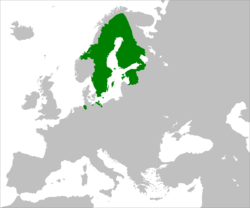Swedish Empire
| Kingdom of Sweden | ||||||||||
| Konungariket Sverige | ||||||||||
|
||||||||||
|
||||||||||
|
The Swedish Empire at its height in 1658. Overseas possessions are not shown.
|
||||||||||
|
All territories ever posessed by the Swedish Empire shown on modern borders.
|
||||||||||
| Capital | ||||||||||
| Languages | Swedish, Finnish, Norwegian, Estonian, Sami languages, Low German, Latin, Livonian, Latvian, Danish, Russian | |||||||||
| Religion | Official religion: Lutheran Minority religion: Eastern Orthodox |
|||||||||
| Government | Absolute monarchy | |||||||||
| Monarch | ||||||||||
| • | 1611–1632 | Gustav II Adolph (first) | ||||||||
| • | 1720–1721 | Frederick I (last) | ||||||||
| Lord High Chancellor | ||||||||||
| • | 1612–1654 | Axel Oxenstierna | ||||||||
| • | 1654–1656 | Erik Oxenstierna | ||||||||
| • | 1660–1680 | Magnus Gabriel de la Gardie | ||||||||
| Legislature | Riksdag | |||||||||
| • | Council of the Realm | Riksrådet | ||||||||
| Historical era | Early Modern | |||||||||
| • | Established | 1611 | ||||||||
| • | Disestablished | 1721 | ||||||||
| Population | ||||||||||
| • | 17th century est. | 2,500,000 | ||||||||
| Currency | Riksdaler | |||||||||
|
||||||||||
| Today part of | ||||||||||
| ^a Office vacant from 1656 to 1660; replaced in 1680 with the office of "President of the Chancellery" as an absolute monarchy was established. ^b Bornholm and Trøndelag were relinquished by the Treaty of Roskilde in 1658. Neither territory was effectively controlled by Sweden. Both territories were restored two years later by the Treaty of Copenhagen in 1660. |
||||||||||
Metropolitan Sweden
Overseas colonies
The Swedish Empire (Swedish: stormaktstiden, "the era of great power") refers to the Kingdom of Sweden's territorial control of much of the Baltic region during the 17th and early 18th centuries, a time when Sweden was one of the great European powers. The beginning of the Empire is usually taken as the reign of Gustavus Adolphus, who ascended the throne in 1611, and the end as the loss of territories in 1721 following the Great Northern War. In Swedish history, the period is referred to as stormaktstiden, literally meaning "the Great Power era".
After the death of Gustavus Adolphus in 1632, the empire was, over lengthy periods, controlled by part of the high nobility, most prominently the Oxenstierna family, acting as tutors for minor regents. The interests of the high nobility contrasted with the uniformity policy (i.e., the upholding of the traditional equality in status of the Swedish estates favoured by the kings and peasantry). In territories acquired during the periods of de facto noble rule, serfdom was not abolished, and there was also a trend to set up respective estates in Sweden proper. The Great Reduction of 1680 put an end to these efforts of the nobility and required them to return estates once gained from the crown to the king. Serfdom, however, remained in force in the dominions acquired in the Holy Roman Empire and in Swedish Estonia, where a consequent application of the uniformity policy was hindered by the treaties by which they were gained.
After the victories in the Thirty Years' War, the climax of the great power era was reached during the Second Northern War, when the primary adversary Denmark was neutralized by the Treaty of Roskilde in 1658. However, in the further course of this war as well as in the subsequent Scanian War, Sweden was able to maintain her empire only with support of her closest ally, France.Charles XI of Sweden consolidated the empire and ensured a period of peace, before Russia, Saxony and Denmark started a concerted attack on his successor, Charles XII. After initial Swedish victories, Charles secured the empire for some time in the Peace of Travendal (1700) and the Treaty of Altranstädt (1706), before the Battle of Poltava (1709) finally brought the great power era of Sweden to an end.
...
Wikipedia




